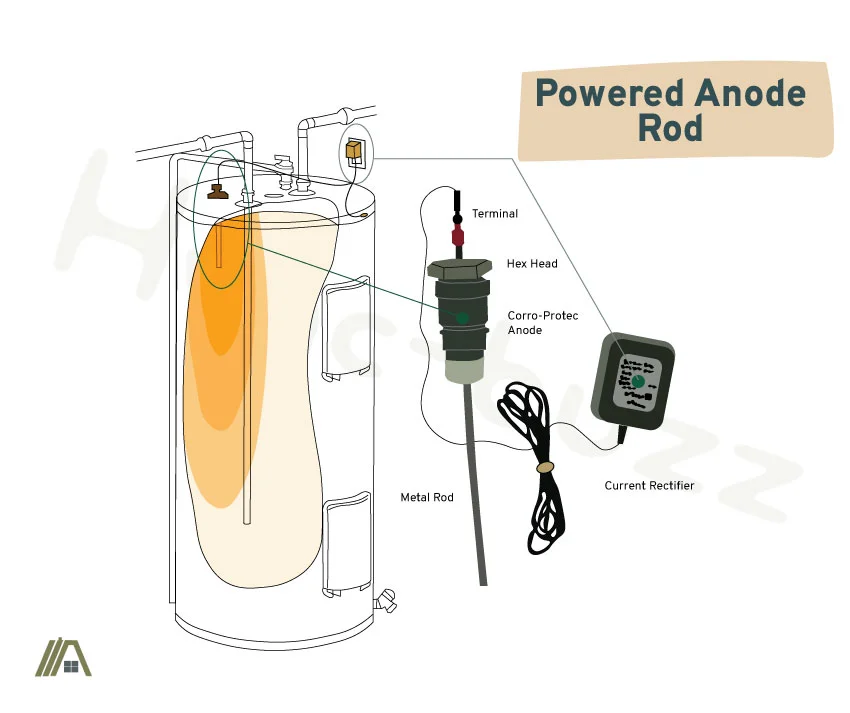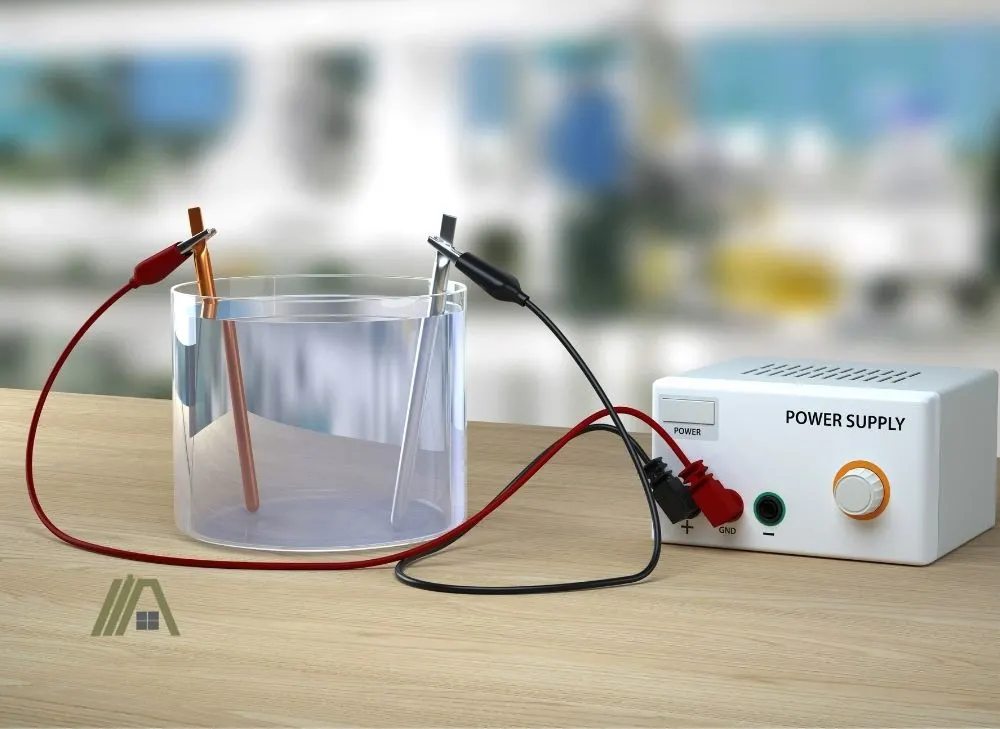Powered anode rods are growing in popularity, and it’s easy to see why. I know I don’t enjoy having to replace my anode every few years, and everything I’ve heard about powered anode rods sounds too good to be true.
I definitely wanted to know what goes on behind the scenes when it comes to the magic of these little rods, and you probably do too. It turns out there is no real secret. The electric current that “powers” them is what handles corrosion, limescale, and stink with no problem. For a better explanation of how that happens, however, read on!

Powered anode rods produce small electrical currents that scatter electrons before they can bind to and corrode a water heater tank. The currents also destabilize calcium molecules so that they cannot attach to the tank, thereby mitigating limescale buildup.
Anatomy of a Powered Anode Rod
At the lower end of a powered anode rod is the metal rod itself, which is made of titanium and is relatively thin. It is attached to a much wider piece made from stainless steel.

This steel section contains the threads that allow the powered rod to screw into the water heater tank at the same location as a traditional sacrificial anode.
At the top of the threads is a hex head, which allows for easy tightening and removal. On top of the hex head is a terminal, onto which a separate piece that includes the wiring harness and control module will be attached.
This separate piece with the wiring harness is what plugs into the wall and the top of the anode rod in order to supply and control the electricity that is key to the functioning of the powered rod.
Mechanism of Action
The powered anode rod is able to prevent and solve multiple issues that can occur with water tanks by making use of a small electrical current that is sent out into your tank. There is no need for self-degradation as with sacrificial anodes.
Powered anode rods are able to sense and automatically adjust to the conditions of your water; the more conductive your water is, the lower the current is. The higher the resistance of your water, the greater the current is.
But what exactly does the current do? It took me a long time to find the answer to this question because I had to delve deeply into chemical redox reactions.
I have a background in science but even so, it took a while to put all the pieces together. Here is a comprehensive but easy-to-understand picture of what I found out:
Metals Lose Electrons Naturally
Metals are able to lose electrons. The more reactive the metal, the more quickly they lose the electrons. Then, in order for a reaction to take place (or the electrons to be used up), a substance that readily accepts electrons needs to be present. Oxygen, which exists in every single water molecule, is one such substance.
Your steel water heater tank is notoriously reactive, so the protective anode needs to counter this. Sacrificial anode rods do so by being more reactive. They release enough electrons and do so more readily than steel. Thus, they are able to keep the oxygen “busy” and away from your tank.
Powered anode rods, on the other hand, are made from titanium, which is a decidedly unreactive metal (that’s why they can put it in human bodies so successfully). Instead of sacrificing themselves, they protect themselves so that they last a long time in the water and protect the tank via electrical currents or pulses.
Electric Current Prevents Electron Loss
I can’t get into this side of things without making getting overly technical, so let’s just say that the flowing current (which is essentially a charge), acts on the electrons (also charged particles) to keep them from escaping the metal.
When the loss of electrons from the metal is slowed or halted by the electric current, it means that there are fewer electrons available for oxygen to steal or accept and it cannot bind to the tank. I.e., the tank cannot oxidize or corrode.
Pulsing Current Keeps Oxygen From Binding
Furthermore, the pulsating nature of the current keeps individual oxygen atoms/molecules from being in contact with the metal long enough to bind with any electrons that are lost.
Yes, water is constantly in contact with the tank when we look at it with the naked eye. But corrosion happens on a molecular/atomic scale and if you were to look at it on this scale, you would see that no (or very few) individual oxygens stay against the tank long enough to react and bind to the metal.
Minerals Also Scattered By Pulsing
Similarly, the pulsing electrical current helps to keep minerals like calcium from building up on the tank. Any that do affix there can still be knocked off again by the pulse.
When minerals build up on the tank, they can degrade the surface, making it more vulnerable to oxidation or corrosion. So, but stopping the mineral build-up, the powered anode rod provides another layer of tank protection.
Electrical Current Kills Bacteria
Lastly, this electrical current is able to kill any bacteria that may be causing your water to smell eggy or sulfurous.
Installing a Powered Anode Rod
The steps for installing a powered anode rod are quite simple and similar to the installation of sacrificial rods. Note that the following is not a detailed guide, but a brief explanation of how to remove and install an anode.
- First, it is important to cut out the power supply to your water tank, whether gas or electric. This will enable you to safely drain your tank and remove the old anode rod.
- If the old anode rod is badly corroded, it may seize and be difficult to remove without the help of an additional tool like a breaker bar or an impact wrench.
- Once the old rod is removed, however, the new powered anode can be put in its place. Once it’s tightened down and secured, the control module and wiring harness that will supply electricity to the rod can be attached.
If you are a visual learner or want a more in-depth tutorial, you may benefit from watching this video. This video specifically covers a Corro-Protec anode rod (amazon link), but the process will be similar for any brand.
Are Powered Anode Rods Shock Risks?
With a water heater and a powered anode rod, you have a combination of water and electricity. This is quite a dangerous combination normally, but what is the degree of risk in this particular case?
Powered anode rods are completely safe during normal use and operation. The level of electrical current that is sent out into the water is not large enough to be a safety risk in regard to the water itself.
However, powered rods are still electrical devices. During installation or a maintenance check, you should make sure to take proper precautions to reduce the risk of shock.
Namely, you should cut power to the socket that the rod will be plugged into before performing any type of handling.
If you have an electric water heater, it is important to also ensure the power to the water heater itself is off before servicing. A non-contact circuit tester like this KAIWEETS Voltage Tester (amazon link) can be used to confirm the lack of power before further engagement.
For additional security, it doesn’t hurt to wear non-conductive gloves when handling the rod.
Are Powered Anode Rods Really Effective?
Powered anode rods truly are effective and they’ve actually been around for quite some time, though they have only more recently become much more accessible.
In fact, they are so effective that it is actually recommended to install a powered anode rod if you have smelly water or use water softeners.

Soft water is a friendlier environment for the sulfur-reducing bacteria that commonly cause the eggy smell that plagues the water of some homes.
Magnesium rods, which are recommended for soft water, will only contribute to the smell, and the zinc rods that can help kill the bacteria are not recommended for soft water (only for softened water—there’s a difference). Powered anode rods, being able to handle any water conditions, are a fantastic solution.
Powered anode rods are quite good at mitigating this issue, and are marketed as lasting for a heater’s entire lifespan, because they will also effectively halt corrosion for as long as they function.
Not only are they meant to last for decades, but in the case of stinky water, results may be seen—or smelled, rather—within just a day of installation.
Do Powered Electrodes Work With Any Model?
Powered anode rods are designed to work with any water heater that uses an anode rod.
Anode rods may vary in length and material, but they are all (with the exception of Buderus and Bradford White brand heaters) built to fit into the same type and diameter of socket, so installation is pretty universal.
No matter what type of water heater you are looking to protect, it is likely that you will find a compatible powered rod.
However, the size of the tank that a powered rod will be able to work with will depend on what model or brand of rod you get, much like with sacrificial anode rods.
Sources
https://www.aosmith.com/News/Archives/2018-Archives/AOS-Product-Preservers-Powered-Anode-System/
https://www.corroprotec.com/f-a-q/
https://www.corroprotec.com/powered-anode-rod/
https://homeinspectioninsider.com/powered-anode-rods/
https://homeinspectioninsider.com/water-heater-anode-rods/
https://www.hotwater.com/lit/im/com-accessories/100305154.pdf
https://kylesgarage.com/powered-anode-rod-vs-sacrificial-anode-rod/
https://www.plumbingsupply.com/understanding-water-heater-anode-rods.html

